In the custard apple flower, pollen shedding and ovary
receptivity are often poorly synchronised and this minimises the
chances of adequate and complete pollination. As a result, natural
fruit set and shape are poor in some varieties. Hand pollination is a
technique developed to overcome these problems.
Understanding custard apple pollination
The custard apple flower
The
custard apple flower is hermaphroditic (male and female parts in the
same flower) and exhibits protogynous dichogamy, which means that the
stigmas or female receptors are receptive before the pollen is shed by
the male anthers. This separation of the female and the male stages
limits the level of natural self-pollination in most varieties to
between 0 and 8% (Table 24).
Table 24. Self-pollination percentages of major varieties
| Varieties with no self-pollination (0%) | Varieties with low self-pollination (1 to 3%) | Varieties with good self-pollination (more than 3%) |
| Pinks Mammoth | Hillary White | African Pride |
| Martin | Gefner |
| Most cherimoyas | Maroochy Gold |
| | Maroochy Red |
| | Fino de Jete |
The
degree of natural self-pollination depends on several factors, some of
which can be manipulated to some extent by the grower (Table 25).
Table 25. Factors affecting natural self-pollination
| Requirement for self-pollination | Factors affecting self-pollination | Impact |
| 1. Stigmas receptive | Relative humidity | 70 to 90% ideal (afternoon showers beneficial)
· less than 60% or more than 90% detrimental (heavy or prolonged rain detrimental) |
| 2. Viable pollen | Temperature
Relative humidity | · higher than 35° C detrimental
· 40 to 65% ideal
· more than 95% detrimental
· optimum level beneficial |
| 3. Pollen transfer | Boron nutrition
Pollinator insects (see below) | · thought to be responsible for 70% of natural self-pollination |
| 4. Fertilisation | Flower self-incompatibility | · high in Pinks Mammoth and Hillary White
· low in African Pride |
Wind has very little impact on the level of natural self-pollination.
Insect pollination
Studies
in Australia and Israel have shown that the main insect pollinators of
custard apple flowers are nitidulid beetles (Family— Nitidulae) (Figure
59). These beetles can transfer pollen from the anthers to the stigmas
in the same flower or to other flowers.
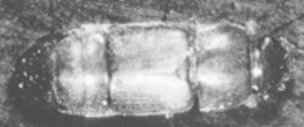
Figure 59. Closeup of nitidulid beetleThe
population of nitidulid beetles in orchards at flowering time varies
considerably and is influenced by many factors (Table 26).
Table 26.
Factors affecting population build-up of nitidulid beetles
| Factor | How it impacts |
| Availability of rotting fruit | Rotting
fruit acts as a food source and attracts nitidulid beetles into the
orchard. However, as it may be a more preferred source of food and
shelter than custard apple flowers, it needs to be managed carefully.
The most favourable conditions for build-up of nitidulid beetles in
rotting fruit are high temperatures (25 to 30° C) and high humidities
(75 to 95% RH). |
| Soil temperature | High soil
temperatures (over 28° C) seem to stimulate massed flights of beetles
and increase their likelihood of entering custard apple flowers. |
| Wind | Nitidulid beetles are weak fliers, even in light winds. This reduces their movement into custard apple flowers. |
| Rainfall | Rainfall
and high humidities appear to be detrimental to beetle activity by
reducing their flight and by reducing the attractiveness of the scent
of custard apple flowers |
Maximising natural self-pollinationThe best techniques for improving natural self-pollination are:
• maintaining high humidities in the orchard by late afternoon sprinkling;
• increasing nitidulid beetle populations in the orchard by placing rotting fruit attractants;
• using windbreaks to reduce wind movement and improve the movement of nitidulid beetles into the flowers;
• ensuring boron levels are maintained in the optimum range to maximise pollen viability.
An
understanding of the process of natural self-pollination is important
for improving productivity and for developing improved varieties.
As
varieties with high levels of natural self-pollination appear to have
more self-compatible flowers, as well as heavily scented flowers more
attractive to nitidulid beetles, these characteristics can be screened
for in new variety breeding programs.
Hand pollinationVarieties
with very low or no natural self-pollination (for example Pinks Mammoth
and Hillary White) will have poor fruit set, yield and shape if allowed
to self-pollinate naturally. Hand pollination is necessary to achieve
commercially acceptable yields and fruit quality. On the other hand,
varieties such as African Pride, which are self- compatible, produce
heavy yields and good fruit shape without hand pollination.
However, besides improving fruit set, yield and shape, there are other reasons for hand pollination. These are to:
•
manipulate flowering and fruit set and hence the harvest period to take
advantage of high-priced, early or late season markets;
• manipulate the length of the harvest season;
• improve fruit size;
• overcome low pollen viability in early season flowers where an early crop is being sought (particularly in African Pride);
• overcome low natural self-pollination in drier areas where low humidities reduce stigma receptivity and pollen viability.
Sources of pollen for hand pollinationThe
best source of pollen is flowers of the African Pride variety. This
variety produces large numbers of flowers and has a high degree of
self- compatibility. By contrast, Pinks Mammoth produces few flowers
and has a low level of self-compatibility. Growers of Pinks Mammoth and
Hillary White should have some African Pride trees in their orchard to
provide a source of pollen for hand pollination.
Collection and storage of pollenPick
flowers from which pollen is to be collected during mid to late
afternoon. Suitable flowers have petals nearly fully opened (Figure
60). The pollen sacs are creamy-grey and less tightly packed together;
immature pollen sacs are white and tightly packed (Figure 61).
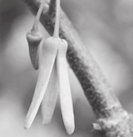 Figure 60
Figure 60.
Flower suitable for collection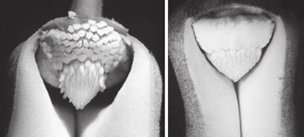 Figure 61
Figure 61.
Left:
flowers ready for collection, showing the pollen sacs separating (this
flower is in the male stage). Right: immature pollen sacs are white and
tightly packed (this flower is still in the female stage)
On
hot days with low humidity, the flowers will release their pollen sacs
readily. Collect these by shaking the flowers over a piece of paper
(Figure 62). Place the pollen sacs in a small open container and store
at room temperature (less than 20 ° C) overnight for use the next
morning. Discard the petals and flower stems.
 Figure 62
Figure 62.
Left: pollen sacs separated from the flower. Right: close-up of pollen sacs, showing released pollen grainsIf
the pollen sacs do not readily separate from the flowers, spread the
flowers in a shallow layer in a tray and leave overnight. Pollen sacs
can then be separated the next morning by again shaking the flowers
over a piece of paper. Discard the petals and flower stems.
Do
not store flowers in a closed container while waiting for pollen sacs
to separate. A build-up of ethylene and moisture causes the pollen sacs
to turn brown and pollen germination is significantly reduced.
Use
the pollen within 24 hours of collection. About 20 to 30 collected
flowers should provide enough pollen to pollinate about 50 to 60
flowers.
Methods of pollen applicationThere are three main methods for applying pollen to the flowers:
• camel hair brush
• pollination gun
• puffer.
All
three can be used with the pollen undiluted or diluted with lycopodium
dust or PVC dust. Dilution enables the pollen to go further as well as
making it flow better through guns and puffers. However, the three
methods are effective only when pollen is not strongly diluted.
Camel hair brushThis is a standard soft hair brush with the bristles trimmed (Figure 63).
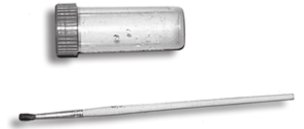 Figure 63
Figure 63.
Camel hair brush and pollen container for use in the fieldThe
camel hair brush method is the most effective because it applies the
greatest amount of pollen to the stigmas of the flowers. As a result,
the best fruit set and symmetry is produced. Fruit set and quality is
only affected when pollen is diluted more than 30%.
Pollination gunPollination
guns have the advantage that flowers can be pollinated much more
quickly (from two to five times the pollination rate) than with the
camel hair brush.
However, most guns do not apply the pollen as
accurately and as uniformly as the brush. Guns also do not work well at
upward angles as there is often not enough pressure to push the pollen
upwards into the flower. Pressurised guns would overcome this problem
but this is not a feature of most currently available guns.
In
Queensland, however, the Japanese persimmon pollination gun (Figure 64)
has been redesigned and early field-testing has shown it to be highly
effective. At low dilution rates, the pollination gun produced fruit
symmetry comparable with that of the brush application tech- nique and
fruit set only slightly lower. This slight reduction in fruit set would
be more than compensated by the increased pollination rate of the gun.
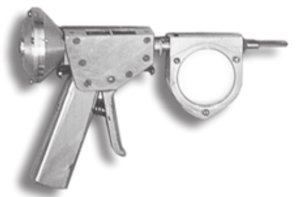 Figure 64
Figure 64.
Prototype of the Japanese persimmon pollination gunPufferPuffers
consist of an air bladder, pollen container and fine discharge tube
(Figure 65). They have similar advantages and disadvantages to the
pollination gun but they need to be held upright to discharge properly.
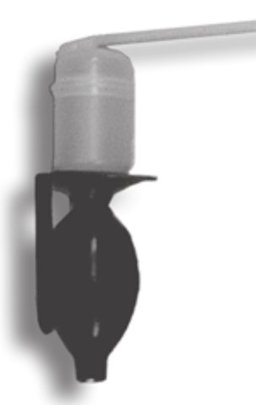 Figure 65
Figure 65.
PufferPollen dilutionPollen
can be used undiluted or diluted with a carrier such as lycopodium dust
or PVC dust. Dilution enables the pollen to go further as well as
making it flow better through guns and puffers.
Dilution,
however, reduces the efficacy of pollination, the degree of reduction
depending on the dilution rate and the carrier used. Research has shown
that at low levels of dilution (1 g of carrier per pollen sacs from 100
flowers), there is only a 10 to 15% reduction in fruit set compared to
undiluted pollen. Both carriers give similar results. Fruit symmetry
for the diluted pollen is similar to that for undiluted pollen.
At
higher rates of dilution (2 g of carrier per pollen sacs from 100
flowers), there is a 30% reduction in fruit set using PVC dust and an
85% reduction in fruit set using lycopodium dust compared to undi-
luted pollen. It appears that the pollen grains adhere much more easily
to PVC dust than they do to lycopodium dust. In addition, fruit
symmetry for the lycopodium carrier was adversely affected, whereas it
was relatively unaffected by the PVC carrier.
These results
indicate that lycopodium carrier should never be used at the high rate.
PVC dust is only suggested at the high rate in mid season, when pollen
viability is high (Table 27). PVC dust is also cheaper than lycopodium.
Pollen
carriers should be used in the knowledge that fruit set will always be
slightly reduced. The benefit, however, is the increased number of
flowers that can be pollinated per gram of pollen harvested.
Table 27. Guide to dilution rates for hand pollination
| Carrier type | Dilution rate
(grams of carrier per pollen sacs collected from 100 flowers) |
| Early season | Mid season | Late season |
| Lycopodium | 1.0 | 1.0 | 1.0 |
| PVC | 1.0 | 2.0 | 1.0 |
Pollinating flowersHand
pollinate in the morning, preferably before about 7.00 a.m. but no
later than about 11.00 a.m. Select flowers in the female stage (Figure
66).
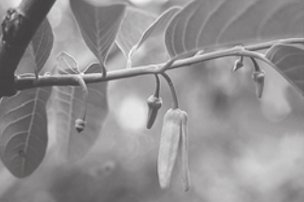
Figure 66. Flower ready for pollination
If
using the camel hair brush, carry the pollen in a suitable container
(Figure 63) which can be conveniently placed in a chest pocket or hung
around the neck.
Gently separate the petals and transfer pollen
from the container of pollen sacs to the female parts of the flower.
Gently twist the brush to ensure even pollination of all stigmas
(Figure 67). The number of stigmas pollinated will determine the
potential size and shape of the fruit.
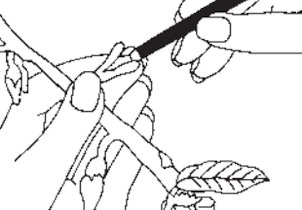
Figure 67. Hand pollinating flowers with the camel hair brush
Frequency of hand pollination
Trees
can be hand pollinated every week during the flowering period. For each
tree, to prevent overcropping and reduced fruit size, record the number
of flowers pollinated and those that set fruit. Manipulating the time
of harvest
In south-east Queensland, the fruit development
period for African Pride is about 26 weeks, and for Hillary White and
Pinks Mammoth about 19 weeks. Depending on location, an earlier or
later crop can be produced by intensifying the amount of hand
pollination at the beginning of the season for African Pride and at the
end of the season for Hillary White and Pinks Mammoth.
Economics of hand pollination
Using
the brush technique, about 150 to 200 flowers can be hand pollinated
per hour, with a success rate of between 50 and 100%. Using pollination
guns and puffers, the rate can be increased to 400 flowers per hour.
With
the brush technique, and assuming a minimum success rate of 75%, about
110 to 150 fruit could be set for every hour of hand pollination. This
is equivalent to about 8 to 12 trays of fruit. Using an average price
of $10 per tray, a gross return of $80 to $120 could be obtained for
every hour of hand pollination. Gross returns could be increased
significantly when hand pollination is used to target early season
fruit for the high quality export market.
Factors affecting fruit set
The
success of hand pollination depends largely on environmental conditions
during fruit set. The physiological status of the tree plays a less
important role.
Environment
Environmental conditions conducive to high fruit set are:
• high relative humidity
• moderate temperatures
• no heavy rainfall
• adequate moisture supply to the tree
• still conditions with little wind.
Of these, relative humidity, temperature and rainfall play the most important role.
Relative humidity.
If relative humidity falls below about 70%, fruit set and shape is
adversely affected. Good windbreaks help to maintain high relative
humidity in the orchard. Light applications of irrigation using wide
throw minisprinklers in the late afternoon also helps flowers to
maintain their stigma receptivity until the next morning.
Temperature.
Fruit set is reduced if flowers are pollinated during the hottest part
of the day. The most favourable time to hand pollinate flowers is in
the early morning before 11.00 a.m.
Rainfall. As fruit set is reduced by free water on the flowers, avoid hand pollination on days of light rain.
Trees
Fruit
set is reduced during periods of strong vegetative flushing because of
the competition between the growing shoots and the flowers.
Larger flowers (40 to 50 mm long) on the basal nodes of shoots set better fruit than smaller ones closer to the tips.
Trees
in a good state of health set better crops. Pay close attention to
nutrition and irrigation; boron nutrition is particularly important.
Foliar applications of boron during the flowering period will generally
enhance fruit set and quality.
This
publication was last revised in 1998. The information is not current
and the accuracy of the information cannot be guaranteed by the State
of Queensland.









